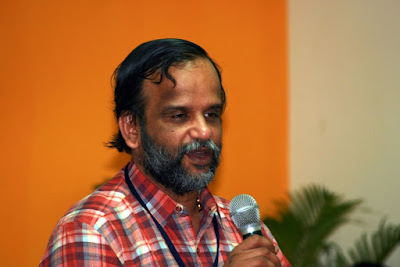Most of the fair sex are made to believe that one of their basic insecurities is their physical weakness, which makes them incapable of effective self-defence against the stronger sex. Is the recent increase in the number of rape and molestation cases proving this hypothesis right?
 “Definitely not,” is the quick reply from Sivan Gurukkal, who runs Sree Agasthya Kalari at Panampilly Nagar for women. “It is our frame of mind that can either become our weakness or our strength during such precarious situations,” he said. “One deep stare can make the enemy think twice before he makes his first move,” he added.
“Definitely not,” is the quick reply from Sivan Gurukkal, who runs Sree Agasthya Kalari at Panampilly Nagar for women. “It is our frame of mind that can either become our weakness or our strength during such precarious situations,” he said. “One deep stare can make the enemy think twice before he makes his first move,” he added.According to Sivan, a rival can at once sense whether you are scared or not. “Your fear always gives the enemy an edge to make the first move. Presence of mind during such situations always comes handy. What women have to realize is that just one blow at the right point at the right time is enough to make their rival’s jaw drop in awe.” ‘Adithadavu’ and ‘Chuvadukal’ are the basic moves in Kalari which can help women in a huge way, says Sivan. The former deals with how to prevent the attacks and the latter is regarding the movements of the leg. Most of the times, women do react to suspicious situations but feel lost when their moves are prevented effectively by the enemy. “That should not be allowed. For instance, if you catch somebody by his shirt, without wasting time just swung him around and place his head between the elbow. It would completely leave the opponent in a fix,” he says. Sivan also said that even the usual accessories that women carry along with them like ‘duppatta,’ bag, umbrella and the like can also be used as effective weapons.
Sindhu , who has been under the tutelage of Sivan for about a year and a teacher by profession, is of the opinion that Kalari should be made a part of the curriculum, especially, for those between 10 to 16 years of age. “I am a teacher and associate with students quite often. I understand that the girl children are no more safe today. Underestimated stamina is the major reason for it,” Sindhu said. She added that she prefers Kalari as it make a person not only dynamic but mentally strong. “This form of martial art has been modified to suit women better,” Sindhu said.
Dominic Presentation, former sports minister and Mattanchery MLA, also said that girls should be taught Kalari. “It can mitigate the problems faced by women to a great extent,” he said. Although, this martial art form is of immense benefit, Sivan Gurukkal, who works in Canara Bank, Arakkunam
branch, laments that it has not been given its due.
by Shalet Jimmy
published in the New Indian Express


